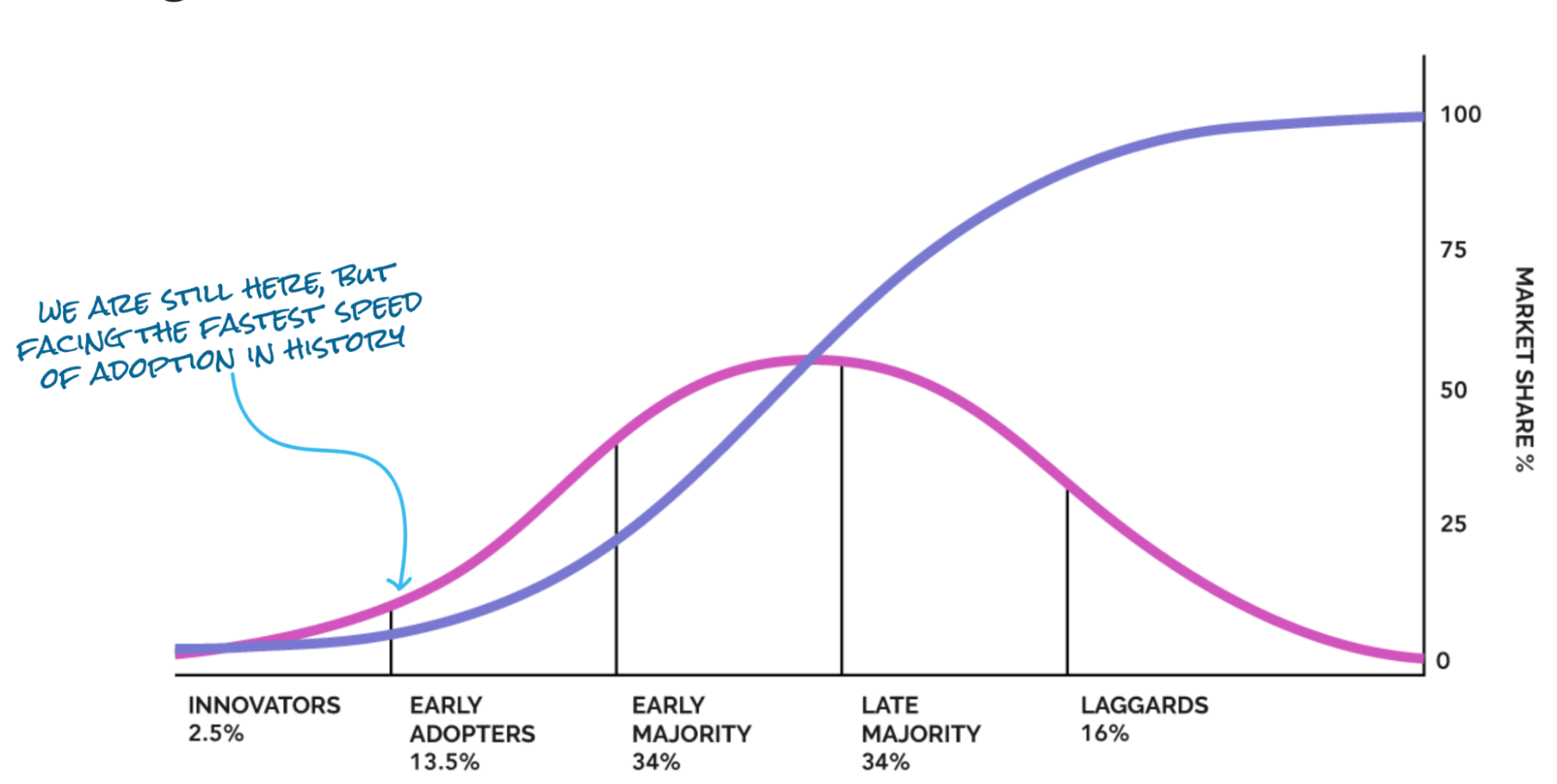The 12 Laws of AI – Law 12: The Law of Ascendency
January 23, 2024
The following is part of our blog series “The 12 Laws of AI.” The series is a set of practical and philosophical guidelines for DMOs to work from as they explore the opportunities and challenges of artificial intelligence (AI). Check out the previous blog in this series, “The 12 Laws of AI – Law 11: The Law of Creative Exploration“
Law 12: The Law of Ascendency
In 1942, an Austrian-American economist, Joseph Schumpeter, coined the paradoxical term ‘creative destruction’ to explain how economies and businesses develop under long waves of innovation. The intersection of AI’s impact on business and Joseph Schumpeter’s theory of long waves of innovation (also known as Schumpeterian waves) is fascinating, even if studying economic theory differs from your cup of tea.

Schumpeter theorized that capitalist economies develop in cyclic waves of innovation, where new technologies disrupt old ones, leading to bursts of activity and growth. These waves are often linked to transformative technologies or industry clusters like the railroad, aviation, agriculture, or the digital realm. Each wave was succeeded by a subsequent, steeper wave that built upon the wave or waves before it, even as it disrupted (or even ended the utility) the technologies, industries, and businesses contained in the preceding wave.
The fact that each wave of innovation is steeper than before explains how someone born in 1600 and living 70 years until 1670 saw little change in the world around them. Compare that to a person born in 1900 residing until 1970: they would have witnessed the move from horse-drawn wagons to the automobile, the birth of aviation, the atom bomb, man landing on the moon, television, supersonic airliners, and the rise of computers.

We are currently in the beginning stages of the sixth wave; the fifth wave brought us the internet, digital media, smartphones, and a new social construct built around social media. The headliner of this new wave, alongside disruptive technologies like drones and clean tech, are the artificial intelligence platforms we’ve been discussing in the 12 Laws of AI series.
Just as the railroad, aviation, and the internet dramatically changed our world in the 20th century, AI represents a disruptive technological wave already impacting nearly every aspect of business and our personal lives. The ability of AI to process vast amounts of data, learn from patterns, and automate complex tasks is quickly altering the foundations of industry and daily life. Although the rise of generative AI platforms has brought AI into the mainstream consciousness, Amazon, Meta, Spotify, Google, and Netflix have employed AI for years, amongst other uses, to predict what consumers want before we realize it ourselves. ChatGPT, Google Bard, DALL E, and other low-cost AI platforms are speeding up the disruption process by democratizing access to these types of capabilities that were the realm of these Fortune 50-style companies just a few years ago. As we’ve explored throughout this blog series, AI can do far more than predict the next movie you should watch; it can, in effect, make you and your team “superhuman.”
It is worth repeating that, in its current format, artificial intelligence is nowhere close to resembling the capabilities of Arnold Schwarzenegger’s Terminator or the treacherous android featured in Alien. There are real concerns, real threats to public safety that must be managed, and almost certainly jobs that will be altered or outright eliminated. This is nothing new, however. The tractor changed agriculture forever—eliminating jobs but creating new ones. The internet and smartphones eliminated printed phone books and pay phones but created new social media, digital marketing, and e-commerce industries. AI and this sixth wave of innovation will spawn new business models and drive economic growth centered around leaps in efficiency, democratized innovation, new employment sectors, and continued digital globalization.
In travel and tourism, we see how quickly generative AI platforms change everything around us. From travel-focused chatbots to assist visitors with trip planning to AI-enhanced marketing efforts and new operational efficiencies…you only need to look at the agenda of your next DMO or travel industry conference to see what is dominating the conversation. Still, it’s easy to dismiss ChatGPT, Google Bard, and similar tools as a fad or succumb to the fear that AI is out to get your job. The purpose of this blog series has been to inform you what AI is, what it is not, and what the challenges and concerns are, but also to introduce the incredible opportunities available regardless of your personal skill set, the size of your organization, or which part of the travel industry it resides in.
Change is inevitable, but it is up to each of us to decide when to jump in and embrace it. Fortunately, the train is just leaving the station in this new era, but the pace of change and disruption will be the fastest seen yet in human history. Businesses had the better part of a decade to adopt the internet into their operations (or to invent brand new ventures like Amazon and Facebook). AI-powered innovation will force us to adapt quicker than ever, evolving into a new competitive landscape and facing new challenges our predecessors couldn’t have imagined (imagine trying to explain to a marketing executive from 1965 what a social media manager does today!).

The 12 Laws of AI guide you to getting started in this exciting, somewhat intimidating, new arena. There are many fantastic resources out there to learn from. A few of my personal favorites have been the book “Prediction Machines, Updated and Expanded: The Simple Economics of Artificial Intelligence” by Ajay Agrawal, Joshua Gans, and Avi Goldfarb, numerous articles that can be found in the Harvard Business Review, the website “Towards AI,” and the “AI Podcast” presented by Nvidia.
Thank you for following along “The 12 Laws of AI” series. If you have questions about anything you’ve read throughout the series, feel free to reach out to the author, Matt Clement.
Other blogs in this series:
Law 1: AI is the Tool, Not the Craftsman
Law 2: Humble Beginnings and Law 3: Transparency
Law 4: The Law of the Imperfect Mirror
Law 5: The Law of Liberated Potential and Law 6: The Law of Collective Empowerment
Law 7: The Law of the Artful Inquiry
Law 8: The Law of Constructive Command
Law 9: The Law of Data Enlightenment
Law 10: The Law of Democratized Innovation
Law 11: The Law of Creative Exploration
Note: This collection of “laws” on AI incorporate insights from my research and writing on the topic. To make it as memorable as I could — and to demonstrate one of the many powerful utilities these tools offer — I asked ChatGPT 4.0 to style my writing in the voice of Robert Greene, author of the best-selling book “The 48 Laws of Power.” I hope you will agree that each of the Laws is a bit more memorable with this distinct style being employed. It’s crucial that we embrace these new tools and transparently acknowledge how they improve our critical thinking and public sharing of ideas.



